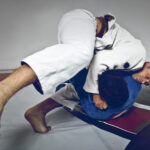If you have ever spent time with Chief Kirk – aka my Dad – you know that he thinks deeply about how to meaningfully impart Krav Maga onto others.
He’s created more Black Belt instructors than any other licensee and formed a powerful cadre of highly skilled teachers – about whom many refer to as “the best instructor cadre anywhere.” So, what’s his secret?
After 25 years of thinking deeply about the way and means that instructors can support students, I thought I would have a conversation with him about the process. Below are my notes – turned into an article – that I collected over the course of several exchanges. It’s definitely worth a review.
Being a Krav Maga instructor isn’t only about teaching punches, kicks, or self-defense techniques. It goes beyond that. As an instructor, your role is to unleash the potential of both your students and yourself. If you’ve been looking for ways to take your teaching skills to the next level, this guide is perfect for you. Let’s get started.
The Science of Learning: How Do People Learn?
Understanding the process of learning is crucial for any instructor aiming to produce outstanding results. The science of learning tells us that people learn best when teaching methods are aligned with their cognitive architecture. Hence, Krav Maga instructors should pay heed to:
Chunking Information: This means breaking down complex moves into smaller parts enhances cognitive retention. And, connecting those smaller parts into a cumulative narrative about how the defense in question will protect the Kravist makes retention even more sticky.
Immediate Feedback: Timing matters. When instructors see a correction, the optimal time to provide feedback is immediately – not after the drill or in a transition period. Effective feedback is immediate. This facilitates reinforcement learning, allowing students to correct their mistakes promptly and with retention.
Practice and Repetition: Studies have shown that repetitive action stimulates myelination, speeding up neural pathways and making specific movements more natural. The Talent Code (Coyle) has some in-depth explanations about this biological phenomenon if you’re interested in more granularity.
Instructors should keep in mind that each student is unique; embracing and recognizing this diversity is essential for successful teaching. People come with different competencies – like linguistic, logical-mathematical, or bodily-kinesthetic aptitude – which must be considered while applying these teaching principles:
Observation and Assessment: Closely observe your students to identify their strengths and areas for improvement. Start at the feet and work your way up. During personal training sessions, ensure the client has a partner – so you can observe their movements. This will help you tailor your approach for maximum effectiveness.
Active Learning: Encourage students to teach certain techniques to the class. It promotes leadership qualities and reinforces their own understanding. Reinforcing understanding is a huge deal. Don’t do this every class, but do insert this into classes with mild frequency.
Socratic Method: Challenge your students by asking probing questions. This encourages critical thinking, which is vital in understanding the principles of Krav Maga and their significance in the application at hand.
As Krav Maga instructors, how we teach is obviously vital, but how we relate information to our students is also a critical skill set. Concepts that support the idea that we can tune into the “frequency” (as Chief Kirk espouses) to deliver the right message or modify intensity can be further improved with the ideas below:
Emotional Intelligence: Emotional intelligence, which involves self-awareness, self-regulation, and empathy, can be as important as technical skill in teaching. By tuning into your students’ emotional states, you can better gauge when to push harder or ease off, resulting in a more impactful learning experience.
Resilience Training: Integrating resilience training like stress inoculation drills or downshifting to breathwork or visualization techniques can prepare your students mentally for the physical and psychological rigors of self-defense. Don’t skip this.
Real-World Application: Incorporate real-life scenarios to make training sessions more practical. The sense of urgency and practical application dramatically enhances learning and retention
Daniel Coyle, in his book “The Talent Code” discusses processes of learning that are central to the development of neural insulation called myelin. Individuals who are able to reinforce and strengthen newly formed neural circuits are able to increase performance in skill acquisition and development.
Chief Kirk’s transformative teaching method serves as a comprehensive framework for internalizing any skill, by creating multiple opportunities for the myelination process to flourish.
Harnessing the Brain/Body Potential
Chief Kirk’s Method: See it, Feel it, Do it, Teach it
See It: This is where Dual Coding (below) and Deep Practice intersect. Demonstrating the technique gives your students a visual model, a target towards which they can aim their defense.
Feel It: This stage corresponds to experiential learning and Coyle’s concept of deep practice. In Krav Maga, the kinesthetic component is crucial. Students must feel the movements, the points of contact, and the transfer of energy to understand the technique at a deeper, more intrinsic level. When done properly, the student also gains confidence in the defense based upon this process.
Do It: This stage is where the rubber meets the road. It’s about active learning, reinforced by myelin thickening. Repeated, purposeful action is what builds the neural pathways that enable skill mastery.
Teach It: This is perhaps the most transformative stage of all. This phase echoes the Socratic Method and Active Learning. In order to teach a concept, one has to dissect it, inquire about its components, and gain insight into its subtleties. This is where they transition from learner to master. Chief Kirk refers to this process as “rent to own.” At first, we rent or borrow information, we work through it, “prove it to ourselves,” and then we own it.
As you engage in the “See It” phase, your brain initiates the development of a neural blueprint. Subsequently, during the phases of “Feel It” and “Do It,” repeated practice acts as the catalyst for myelin growth. Finally, when you progress to “Teach It,” you not only reinforce but also bolster these freshly established neural circuits.
Implementation in the Classroom
In his Masterclass, Chief Kirk employs even more detailed learning tactics to drive towards student mastery of the subject matter. Take a look at these strategies and consider how you might employ them in your classes.
Spaced Repetition: This concept is all about revisiting and reviewing material at increasing intervals over time. It employs the “spacing effect” to improve long-term retention of knowledge. Spaced repetition is not about cramming; it’s about crafting a systematic, disciplined approach to learning that continuously recycles information back into the classroom.
Interleaved Practice: Instead of focusing on a single concept and mastering it before moving on (what’s known as “blocked practice”), interleaved practice involves alternating between different topics or subjects to better retain the information. It can be more challenging, but it significantly boosts comprehension and transfer of knowledge. Even changing the context of how you use a movement in self defense can incorporate this idea.
Dual Coding: This strategy involves combining verbal and visual information to help remember facts. Think graphs, charts, or images alongside text. Usually, Chief Kirk just draws on the white board, but videos can also be used. Remember, visual aids aren’t just colorful or decorative; they are powerful tools that can help lock knowledge in your mind and make it easy to recall.
Retrieval Practice: The act of recalling an answer to a question or problem improves learning and retention more than simply reviewing the material. In essence, testing yourself becomes a highly effective study strategy. So, ask (perhaps require) that students take notes and allow them 5 minutes to review before each subsequent class.
Metacognition: Equip your students with the ability to think about their own thinking. Encourage them to plan, monitor, and evaluate their learning strategies. Being aware of one’s learning process enhances not only retention but also the ability to apply knowledge in different contexts. This can be powerfully applied by asking students to think about how they think about and apply the principles of Krav Maga.
Elaborative Interrogation: This involves asking ‘how’ and ‘why’ questions while thinking about specific defenses. By making connections between new information and existing knowledge, learners create a richer mental tapestry that’s easier to retrieve later. For instructors, it’s easy to tee-up these questions in class discussions – and if needed lead the thought process to enhance deeper understanding.
Mnemonic Devices: Mnemonics like acronyms, visualization, and rhymes can help the brain to remember information. These mental hooks turn abstract data into something more concrete, ordered, and easier to recall. For instance, Chief Kirk tells students to evaluate each Krav Maga defense as applied to “men and women, big and tall, short and small.” With this, we can assess and even design defenses with the aim of Krav Maga at the forefront of our thinking.
OK, enough of the theory and science already. In simple language, remember these axioms to create a richer learning environment:
- Avoid monotonous drills. Mix striking with ground defense or chokes with footwork to challenge your students’ adaptability.
- Implement both visual and verbal cues during your training. Use physical demonstrations in sync with vocal explanations to foster dual encoding in the brain. With this, focus on slow movement and simultaneous explanation.
- Engage in deep practice by focusing intently on each move, transforming every punch, block, and stance into a purposeful endeavor with powerful intention.
- Inspire and relate to your students through storytelling or real-life examples, fostering a sense of urgency and relevance in their learning process.<.li>
- Use immediate and precise feedback to foster quality repetitions and facilitate deep practice. Remember, your aim is to facilitate the growth of myelin around neural circuits for faster skill acquisition.
As you wholeheartedly embrace your role, it’s vital to recognize that you’re not simply an instructor; you’re an facilitator of mastery, a cognitive architect who molds not just fighters, but lifelong learners. Your classroom stretches beyond the confines of a practice space; it evolves into a crucible for profound transformation, where the amalgamation of Chief Kirk’s methods and the scientific insights gleaned from psychology and neuroscience will propel your students toward unmatched excellence.
We can all move beyond mere instruction to become a Krav-centric neural architect. As you distill the wealth of knowledge delved into within the realms of educational psychology and neuroscience within your classroom, remember you’ve got a huge job (and you’ve got the tools to do it!).
In conclusion, becoming an effective Krav Maga instructor isn’t just about mastering the art of self-defense; it’s about mastering the art of teaching. Equip yourself with a deep understanding of learning theories, a keen eye for individual needs, and a toolbox of methods that go beyond traditional teaching. Challenge yourself, stretch your limits, and you’ll inspire your students to do the same.



